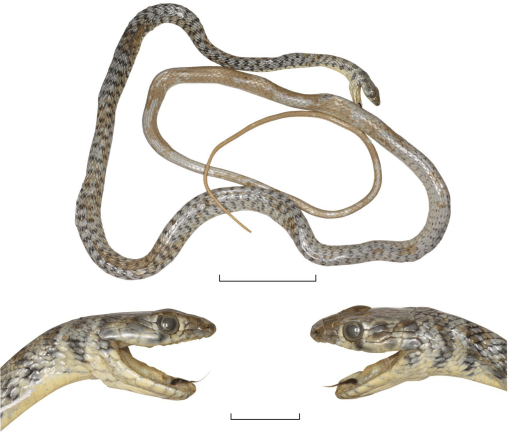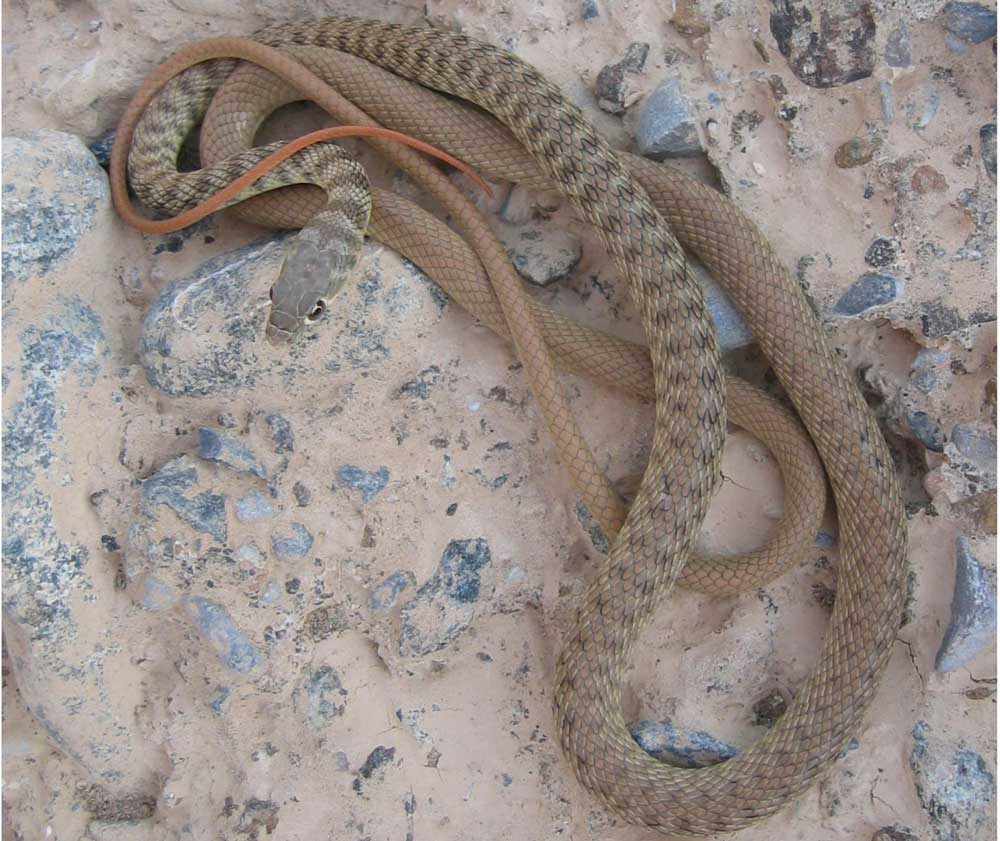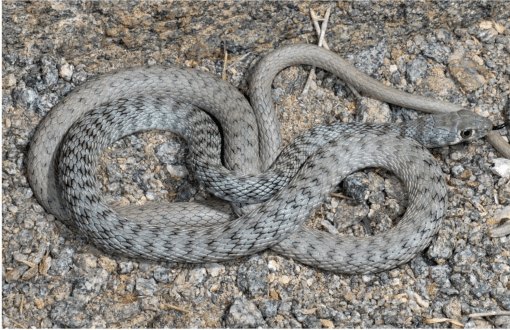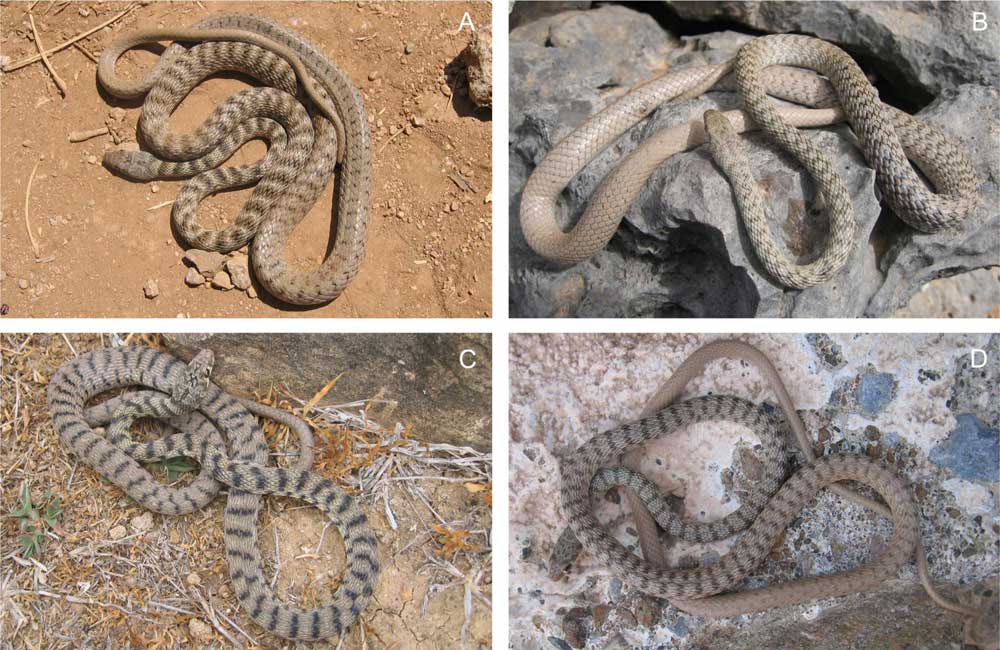The cliff racers had been studied in the late 1800s and into the mid-1900s, but have not been studied as of late and have not benefited from state of the art research technologies.
A chance encounter on a rooftop in Oman led to the identification of three new species of racer snakes known as Arabian cliff racers and of the Platyceps rhodorachis complex.
The snakes are found throughout much of the Eastern Oman Mountains and into islands in the Arabian Sea. They differ morphologically from P. r. rhodorachis which are found beyond Iran and P. gallagheri sp. nov. which are found in the Ras Musandam area of the Musandam Peninsula in Oman. The cliff racers had been studied in the late 1800s and into the mid-1900s, but have not been studied as of late and have not benefited from state of the art research technologies.
The researchers believed that because of so much time passing, that the snakes may have been misidentified or there may have been overlap in species. So the researchers located 90 specimens to study.
The researchers examined 90 cliff racers from Oman and East Yemen from herpetological departments from Abu Dhabi University (ADU); Academy of Natural Sciences, Philadelphia (ANSP); Natural History Museum, London (formerly British Museum [Natural History], BMNH); California Academy of Sciences, San Francisco (CAS); Museum of Comparative Zoology, Harvard University, Cambridge (MCZ); Muséum d’Histoire naturelle Genève (Geneva, MHNG); Museo e Istituto di Zoologia sistematica della Università, Torino (Turin, MZUT, now housed in the Museo Regionale di Scienze Naturali, Torino); Naturhistorisches Museum, Wien (Vienna, NMW, ex NHMW); Oman Natural History Museum, Masqat (ONHM); Museum Koenig, Leibniz-Institut zur Analyse des Biodiversitätswandels, Bonn (former Zoologisches Forschungsinstitut und Museum Alexander Koenig, ZFMK); Museum für Naturkunde, Leibniz-Institut für Evolutions- und Biodiversitätsforschung, Berlin (former Zoologisches Museum, ZMB); Zoologische Staatssammlung, München (Munich, ZSM). Further acronyms used in the text are BNHM (former Bombay Natural History Museum, Mumbai), HUJ (Zoological Museum, Hebrew University, Jerusalem), MDG (Michael Desmond Gallagher’s field collection), and SQU (Sultan Qaboos University, Masqat).

Dorsal aspect and lateral head scales of Platyceps gallagheri sp. nov. (♀ holotype, BMNH 1980.222) from the vicinity of Khasab, Musandam Governorate, Sultanate of Oman. Scale bars equal 50 mm (entire specimen) and 10 mm (head views).
The researchers determined that snakes from the Hajar Mountains of Oman and the United Arab Emirates differed from others on record and determined that these Hajar Mountain cliff racers were a new species. They were four feet in length and varied in coloration with some having distinct patterns while others were plain.
The new species Platyceps gallagheri, or Gallagher’s Cliff Racer has a snout to vent length of 685mm with a 274mm tail. It is known to reside in the limestone mountains of the Ras Mountain region, including “Khasab south of the Maqlab isthmus in northernmost Oman.” It is grayish in coloration (in alcohol) with an olive tinged snout.

Platyceps hajarensis sp. nov. (♂ holotype, MHNG 2664.71) from Fanjah, Ad-Dakhiliyah, Sultanate of Oman
The second new species is the Hajar Cliff Racer (Platyceps hajarensis sp. nov.). It has a snout to vent length of 565mm with a 235mm tail. It is known to occur from “Ras al-Khaymah (incl. Hatta area) and Fujayrah west to extreme south Umm al-Qaywayn and southern Ash-Shariqah (Sharjah) in the UAE, possibly lives in Musandam and through the Hajar and its periphery including the Batinah (see next paragraph, incl. Daimaniyat Island off Barka) and Masqat Governorate south at least to the Wadi Bani Khalid area in Ash-Sharqiyah, and likely occurs as far as the vicinity of Jabal Qarari” It is found in cultivated lands and is known to enter buildings looking for food and shelter. They are considered ambush predators and feed on lizards and birds. It is grayish beige in coloration with an orange tail and with lateral stripes that turn into almost black cube-like patterns on the midsection that fades down into the tail.

General aspect of Platyceps masirae sp. nov. (Masirah Island) in life. Courtesy of Roberto Sindaco
The Masirah Cliff Racer (Platyceps masirae sp. nov.) has a snout to vent length of 440mm with a 159mm tail. It is known to inhabit Masirah Island in the Sultanate of Oman in the Arabian sea. It is a dull olive in coloration with no apparent patterning. It features a dusky band from near its mouth. The dorsum to the midsection is a light grayish olive in coloration.
Compared to the three new species, Platyceps forma inquirenda has a snout to vent length of 890mm in the male and 825mm in the female. The tails were incomplete on both specimens. It is found from “southwest Dhofar littoral through the Jabal Samhan and Qamar ranges inland to Thamarit (Thumrait) and west into Yemen.” It is common at sea level to above 1500 meters above sea level in the Jabal Samhan range.

Dorsal colour pattern variation in marked Dhofar Platyceps forma inquirenda from Deem (A, MHNG 2664.63, ♀), Khadrafi (B, MHNG 2664.62, ♀), and Wadi Kharfawt (C, MHNG 2664.61, ♂) in the Jabal Qamar area, and from the vicinity of Mirbat in Wadi Ayn (D, MHNG 2664.70, ♀), courtesy of Mohammed Sayed Farook.
“This taxon enters gardens and buildings. In mid-May, we observed individuals in rocky places of woods, among piled up stones covered with acacia branches serving as corrals, next to a large boulder in steep terrain, and in a more open area (scattered stones of a grassy patch in scrubland. The Deem female laid four eggs (ca. 500 x 135 mm) on 30th May,” the researchers wrote in their paper. The researchers also say that Platyceps forma inquirenda mimics Echis khosatzkii, a venomous viper species found in Oman and eastern Yemen.
The complete paper published by the Swiss Journal of Zoology, “Three new cliff racer species from the Sultanate of Oman (Reptilia: Squamata: Colubrinae) and zoogeographic traits of its herpetofauna,” can be read on the Bioone.org website.


